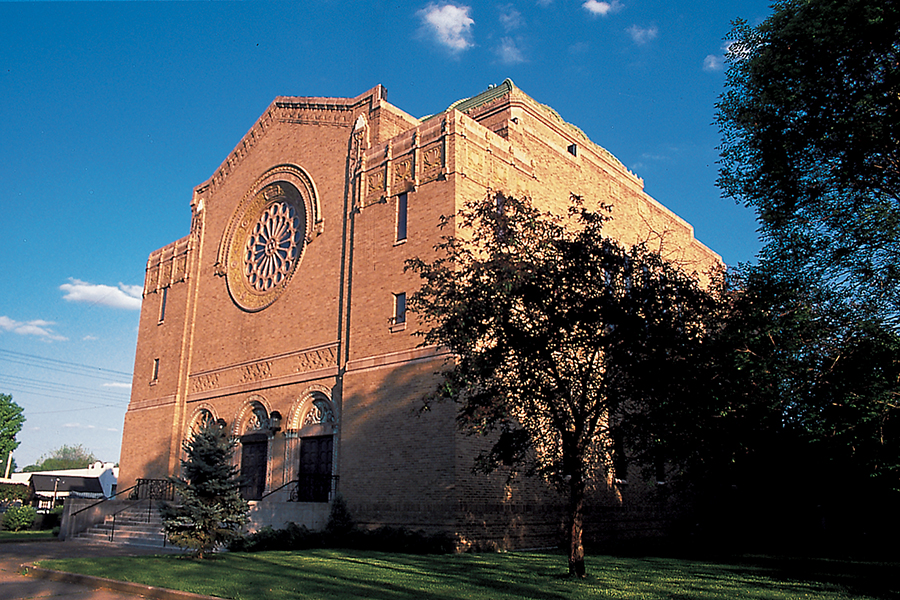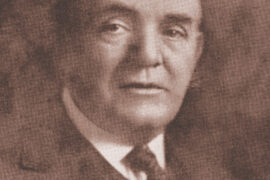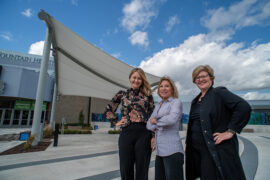Faced with the insurmountable challenge of raising $500,000 to save their historic temple, the small B’Nai Shalom congregation met their goal in what has been described as divine intervention
By Justin McElroy
HQ 52 | SUMMER 2004
For any religious group, their place of worship takes on a significance deeper than brick and mortar. It is a place where births and weddings have been celebrated, deaths have been mourned, and traditions and heritage have been passed through generations. When the B’nai Shalom congregation was faced with the prospect of losing their home, the lengths they went to save it were, in the words of some, miraculous.
The B’nai Shalom building has been a landmark in Huntington since 1925. In 1994, the temple was placed on the National Register of Historic Buildings. It is the only example of Byzantine architecture in the state, characterized by the central dome and the extensive use of surface decoration in the sanctuary.
It had served its congregation well over the decades, however, towards the end of the last century, the building had begun to show its age. Water had begun to creep in through windows and pipes, causing decay in the plaster walls and ornate plaster trim that helps make the temple so distinctive.
Though the crumbling plaster was unsightly, what finally pushed the congregation to act was the discovery of asbestos in the walls of the temple. The asbestos was not an immediate health risk, according to experts, but the temple would soon be unsafe to hold services in.
The congregation of B’nai Shalom was faced with a seemingly insurmountable challenge: either raise the $500,000 it would require to refurbish the building, or be forced to abandon their beloved place of worship.

Dennis Hammel, B’nai Shalom member and Chairman of the Building and Property Committee, was ambivalent about the decision. No one wanted to leave their home, but the task of raising the required funds was daunting.
“We’re not unlike any congregation in that our number has diminished over the years,” said Hammel. “We didn’t have a base from which to draw the funds, we don’t have tithing or anything like that. I just didn’t know how we were going to sustain this.”
After much deliberation, the congregation was settled: they would stay, and attempt to revitalize their temple. Past-President of B’nai Shalom Congregation Dr. Lynne Mayer took the lead in the fund-raising campaign, dubbed “L’Dor V’Dor – From Generation to Generation.”
The fundraising campaign was a phenomenal success, with more than $600,000 being raised for the renovations. Considering the size of his congregation, Herbert Colker (a B’nai Shalom member since 1945) thinks the success of “L’Dor V’Dor” was nothing short of divine intervention.
“I’m 83, and there are three miracles in my lifetime,” said Colker. “One is the defeat of Hitler, the second miracle is the start and survival of Israel, the third miracle was having a congregation of 145 members being able to, with the help of a lot of friends, raise $500,000 in one year. It’s an absolute miracle.”
Though members and former members of B’nai Shalom gave generously, it took a lot of friends to help the congregation reach its lofty goal. Hammel estimates that approximately 25 percent of donations were made by outside parties giving whatever they could.

“People stepped forward,” said Hammel. “There were people who could only give $100 or $50. There were two or three big pledges, the rest weren’t so big.”
With the required funds in hand, the work began in earnest on breathing new life into B’nai Shalom. A year earlier, a waterproofing company from Pennsylvania was brought in to fix the exterior sources of leakage, so congregation members could be sure the project they were about to undertake would not be undone by the weather.
Originally, the entire renovation was to be handled by one outside firm, but when the cost was found to be prohibitive, it was decided that the work would be broken down, and handled by various local companies.
In January of 2003, after all of the pews had been removed and four stories of scaffolding had been erected, Thermal Solutions of Proctorville, Ohio began removing the asbestos. After the temple was found to be free of the substance, work began on the plaster.
After the walls and ceiling had been completed the next hurdle was the intricate ornamental plasterwork throughout the sanctuary. Castings were made of the original works and replicas were created and installed.
To help bring the look of the rejuvenated temple together, an interior designer was brought in on the project. Deborah Pohlman, a local designer, was hired to coordinate colors and choose fixtures for the building. According to Hammel, Pohlman had a “remarkable effect on the project.”

Pohlman drew her primary inspiration for the palette of the sanctuary from the kaleidoscope of colors found in the dazzling stained glass in the sanctuary. The tones were slightly softened so that they could complement the windows without overshadowing them. Pohlman also decided on using 24-karat gold for the trim surrounding the arc at the front of the sanctuary.
Even with some of the major aesthetic elements in place, there was still much work to be done. A new state-of-the-art sound system was installed, lighting fixtures were replaced, storm windows were placed over the dome windows in the sanctuary, new carpeting was lain, even the wooden pulpit got a facelift.
On September 25, 2003, work was completed on the B’nai Shalom Temple. The congregation could not have been more pleased. Member Marilyn Polan was thrilled to see the building that meant so much to her get a fresh start.

“I am just amazed with the way it looks,” said Polan. “I grew up in the sanctuary, I was there a lot. It has historical significance as well as personal. I think to do nothing, to let it disintegrate would have just been unthinkable.”
According to Herbert Colker, the importance of the renovations was not only in revitalizing the sanctuary, but also in the preservation of the legacy left to the current congregation by previous generations.
“Each of the two congregations that joined to form B’nai Shalom are over 100 years old,” said Colker. “You never want to forget the dedication and the sacrifice of hundreds and hundreds of people to create this home for the Jewish community over a hundred years. I think that’s as important as anything. You have to respect the sacrifices of your forebears.”





